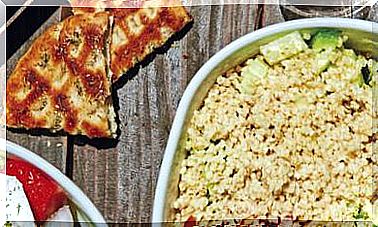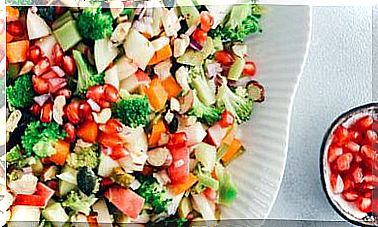4-week Plan To Incorporate Healthy Habits
Sometimes you need to put order in your daily life to feel comfortable. We propose a simple plan to establish healthy habits and notice changes.

According to a saying, a man or a group is only as strong as its weakest point. It is very successful, since sometimes discovering this weak point is the starting point to begin to take care of ourselves, undertake a job or a discipline that makes us stronger or helps us recover from an injury or failure.
An illness reveals our weakness and fragility, but it also helps to activate that will and ability to modify our lifestyle. So, in a way, the weakest part of each person or group is also their strength.
A health plan can be noticed in a month, but it is decided in an instant, here and now.
When you start a health plan it can take a month until we notice some changes, but to start the first thing is to take the step, make the decision. Then you will need practice, daily training and the discipline to carry it out with a defined schedule and routine.
Winter days, with cold and little light, invite you to get up in the morning and begin to warm your body so as not to get cold, to think about how to order the environment that surrounds us, to clean and set fire to everything old, to the firewood, to clear the field so that, every day, with more light, little by little, spring arrives in our reflections.
The need arises to review our activities in daily life to feel better physically, mentally and spiritually. Lifestyle is the most powerful resource in medicine, as it not only helps prevent but also effectively modifies serious chronic disease states.
We propose a health plan to carry out over 28 days (4 weeks), a lunar cycle divided into four parts, very adapted to our calendar and our weekly cycle. It is enough to start noticing changes and it does not require a very sustained effort.
Week 1: know the starting point and start a conscious diet
The main thing is to feel comfortable taking care of yourself and training yourself to be well.
The main part of getting started, as well as starting a good day, is getting a good night’s sleep. Sleep in bed is one of the body’s greatest recuperators.
From there, you have to establish an order in physical exercise and dietary changes, as well as attitudes that help improve survival. In this first week, attention is paid to a healthy diet and to assessing physical condition. I suggest that you pay special attention to these 3 points:
1. Improve your diet: small big changes
To start improving your diet, reduce or eliminate the consumption of:
- Caffeine and other excitements.
- Trans fats from industrial fried foods and those with a high content of omega-6 fatty acids, which cause inflammation. Omega-6 fats are found in many animal products (red meat, dairy products) and in shelf-stable foods, peanuts, partially hydrogenated oils, and most vegetable oils, such as sunflower or soybean.
- Foods rich in simple carbohydrates, that is, with a high glycemic load and that cause a rapid increase in insulin levels. These foods seem to cause more inflammation: sugar, white breads, biscuits, instant rices, and toasted corn and rice cereals.
- Foods that are more likely to trigger intolerance reactions (they vary from person to person): dairy products, wheat, eggs, artificial flavorings and colors.
In addition to reducing the consumption of all of the above, you should increase the amount in the diet of :
- Whole grains.
- High fiber foods .
- Monounsaturated fats, such as olive oil. It is known that excessive levels of omega-6 to omega-3 the increase risk of different disease. Omega-3 fats, such as oil, flaxseeds, or walnuts, are recommended to reduce inflammation .
- Fruits and vegetables. The more servings the better – a good goal is 8-10. Yellow, orange and red vegetables (peppers, carrots) and dark green leafy vegetables (spinach, chard) provide a large amount of antioxidants. Another good option is to have one or two glasses of natural fruit or vegetable juices in season, especially roots (carrots, beets) with apple or celery, or young sprouts of watercress. It is also recommended to increase the consumption of vegetables from the Allium family : leeks, onions, garlic.
- Spices such as ginger, rosemary, turmeric, oregano, cayenne pepper, cloves, or nutmeg, which contain anti-inflammatory compounds .
A good idea is to keep a health plan journal. It records what you eat, the exercise you do, and the well-being or stress you experience.
2. Evaluate your physical condition: how are you in strength, power or speed?
Before starting a fitness program, it is important to know what our physical condition is at that time. Do not be demoralized if the results betray a low level: it is only a starting point.
Some simple tests allow to know different aspects of the physical condition. These two are used to evaluate the cardiovascular and respiratory systems:
- Respiratory capacity: voluntary apnea time. It consists of maintaining a forced inspiration or expiration for as long as possible. The minimum time is 30 seconds for apnea with full lungs and 10 seconds for apnea with empty lungs.
- Cardiac resistance to exertion: Ruffier-Dikson test. Standing, 30 knee bends are performed, trying to bring the thighs parallel to the ground, as if to sit, in a time of 45 seconds. To ensure this time, a metronome can be set at a frequency of oscillation such that its pendulum will beat 80 times in one minute, once on each side. One sound marks when to stoop, and the next, when to get up. This rhythm must be maintained for the 45 seconds.
The pulse is taken at rest before the test (PO), just after finishing the push-ups (P1) and one minute after they have finished (P2). Add these three figures, subtract 200 and divide everything by 10.Results:
- More than 20: Suspect of pathology
- 10 to 20: Bad
- From 5 to 10: Medium
- 1 to 5: Good
- Less than 1: Very good
- Strength: push-ups in suspension from a horizontal bar. This test measures, above all, the muscular strength of the arms, but it helps to get an idea of the general strength.
Hang from a bar without your feet touching the ground, and raise your body by flexing your arms until your chin rises above the bar. Repeat the action as many times as you can.Results :
- In women: 0-1 (regular), 2-3 (good), 4-5 (sporty), 6-7 (very good), 8 or more (excellent)
- In men: 1-3 (regular), 4-6 (good), 7-9 (sporty), 10-12 (very good), 13 or more (excellent)
- Muscle power: jump length with feet together. A mark is made on a flat surface. From that mark, from a position of semi-flexion of the trunk, with the feet parallel and separated at the same distance as the shoulders, without taking prior impulse, swing the arms and jump forward, as far as possible. The centimeters traveled are measured.
Results :
- In women: 130-144 (regular), 145-159 (good), 160-174 (sporty), 175-189 (very good), 190 or more (excellent)
- In men: 160-174 (regular), 175-189 (good), 190-204 (sporty), 205-219 (very good), 220 or more (excellent)
- Speed: sprint of 45 meters. On a flat surface, you measure 45 meters and, after a good warm-up, you run that distance at maximum performance, measuring the time taken with a stopwatch.
Many other similar tests can be improvised. For example, run 20 meters starting from the supine position (lying on your back), with the feet together towards the goal and the arms close to the body.Results:
- In women: 9 “3-8” 8 (regular), 8 “8/7” 3 (good), 8 “2-7” 9 (sports), 7 “8-7 (very good), 6” 9 or less (excellent)
- In men: 7 “8-7” 3 (regular), 7 “2-6” 8 (good), 6 “7-6” 4 (sporty), 6 “3-6 (very good), 5” 9 or less (excellent)
3. Move the joints
To begin to get in shape, during this week we will dedicate half an hour a day to gentle exercise.
It can be a Swedish gymnastics table as a stretching and fine-tuning of the joints. The movements of each joint are reviewed about 5 times, without forcing, just recognizing the terrain.
You can also take a walking, running or cycling tour and schedule it as a daily improvement training. After the walk or run, you become aware of the muscles used and you learn to relax it for a few minutes.
Week 2: improve nutrition and gain physical and mental flexibility
Now is the time to lay the foundation for a healthy diet, intensify your exercise program, and begin exploring a relaxation technique .
1. Good dietary habits available to anyone
During the second week of the health plan, you can review some dietary guidelines to make the most of the benefits of food and enjoy food more :
- Cruder. You have to make sure that half or even more of what you eat is raw food. And in cooked dishes add raw in the form of small pieces, grated, juices, etc.
- Respect the appetite. It is advisable to eat when you have a real appetite and not out of routine. The amount depends on each person, but it is best to stay a little hungry.
- Nice surroundings. Whenever possible, try to eat in a quiet, cheerful place, in pleasant company, with the maximum possible silence and a good mood.
- Savor. Chew, salivate and savor the food well, so that it is liquid when we swallow it. It is good to chew hard food to strengthen your teeth.
- Liquids aside. It is advisable not to drink just water or any other beverage during meals. It is best taken half an hour before or two hours after eating to facilitate digestion, since too much water can dilute gastric juices and exert a satiating effect. The best way to incorporate it during meals is with foods that contain it in a large proportion, such as raw vegetables.
- Steaming. Boiled vegetables, potatoes, etc., it is preferable to steam them or with very little water, over low heat, so that they lose the minimum of nutrients.
- Without obsessing. In some environments there is excessive concern about some incompatibilities between foods. Do not be obsessed: everyone must know their own digestive possibilities and adapt to them.
- With awareness. One way to enjoy food more is to eat mindfully, savoring and chewing well. You have to consider whether or not you watch television while you eat or whether you prefer to fully enjoy your food.
2. Gain flexibility
This phase can be considered as preparation for training. It aims to minimize the risks of injury and teach or resume the dynamics of physical training (warm-up, work and cool-down).
The previous program to loosen the joints is added the so-called “sun salutation” of yoga, a series of chained movements that improve flexibility.
Without straining, special attention is paid to the lower back and the crural area behind the leg. Each stretch is dedicated for 10 to 30 seconds, and repeated 3 to 5 times until a slight tightness is felt. It is done at least three times a week.
On the other hand, aerobic capacities, flexibility, strength, coordination and balance can be improved, taking advantage of daily activities (domestic work or work) and the most playful or games.
The daily route proposed for the first week is given a faster pace and is interspersed with small runs of short duration, of 12 to 20 minutes. At least 3 or 4 non-consecutive sessions are carried out per week.
If you have doubts about the appropriate intensity of the run or exercise, you can measure your heart rate. The maximum heart rate is easily calculated taking into account age, which is subtracted from the number 220.
To alleviate stressful situations, the state of respiration is observed three times a day, perhaps before meals.
Week 3: focus, strength, and healthier choices
The objective of this third week is to abandon unhealthy habits in favor of more beneficial ones.
When it comes to diet, you learn to resort to healthy solutions when you feel like indulging. Strength training is incorporated into the exercise routine and a very simple meditation technique is taught to gain concentration.
1. Re-educate your cravings: what do you drink in times of downturn?
It is a good time to see where it is most difficult to follow a healthy diet and to learn some strategies that allow you to eat smarter in those cases.
- To satisfy the sweet tooth, you can take dried fruits.
- When, on the contrary, what you want is the salty taste and the fats, a good resource is to drink mineral water rich in magnesium, such as Vichy or Carabaña water.
- The energy slumps midafternoon can be overcome by taking pieces of fresh fruit. They are a much healthier alternative to a cup of coffee or a cola.
2. Work strength
To what was proposed in the previous weeks , three days a week of strength exercises are now added. With the help of a monitorto advise on how to perform these movements safely and appropriately for personal capacity, working with weights or concentrating on performing movements that require maximum muscle tension.
- Perform a minimum of 8 to 10 exercises for the main muscle groups and repeat them 8 to 12 times, until you feel tired.
- First increase the number of repetitions and then the load. Never use a load that doesn’t allow for 8 reps.
- Do not exercise for more than an hour at a time. The speed of execution must always be controlled. Never overtrain.
- It is very important to watch the technique of these exercises. You have to seek the greatest possible range of motion, maintain your normal breathing pattern, and do not exert yourself too much. Range of motion should not be painful. These are multi-joint exercises.
3. A simple meditation
Taking 10 or 15 minutes a day to take a break in the day lowers stress levels.
If meditation is imposing because it has never been practiced, it is enough to concentrate on the breath without forcing it, observing it.
You have to sit in a quiet place with your back straight, eyes closed and relaxed jaw, and bring attention to the passage of air from the nostrils to the lungs and every part of the body, and from there back to the outside.
It is also followed by the health diary. You can write down, for example, at what time of the day you feel the most peace. Being aware of all the advances and difficulties helps to stick with the plan.
Week 4: Reinforce what has been achieved
It is about taking another step. It is time to consolidate the achievements and to continue working to improve those aspects that cost the most. With the perspective of the previous three weeks, it is time to reaffirm yourself in the goal of living a healthier life.
1. Thinking about the planet
In the final stretch of the plan, you can still improve your diet taking into account environmental issues :
- Preferring food from organic farming and dietary options that benefit the planet.
- Using reusable cloth bags, opting for food not packed in plastic trays or similar.
- Being interested in the origin of the food that is consumed.
- Enriching the diet by adding seasonal foods, new cereals and the greatest possible nutritional variety.
2. Respect the energy level
As for exercise, joint movements, sun salutation and stretching are incorporated at the beginning and end of the walk or run and strength exercises.
If one day you do not feel like exercising, you can respect your body by resting or seeking a minimum limit, with simple exercises, according to the possibilities and energy of the moment, knowing that you will return to the exercise routine once the levels are restored. of energy.
3. A more conscious life
Breathing awareness can be extended to other activities, such as listening to music, dancing, connecting with nature or with other people, etc.
It can be as effective as meditation in lowering tension, creating joyous moments, and nourishing the spirit. If from these activities we manage to make a routine that makes us enjoy ourselves, we will feel useful, to ourselves and to our health.
It will allow us to know and recognize that we have the capacity and will to discipline ourselves, and that we can choose habits and make decisions that involve our health and the health of those around us.









